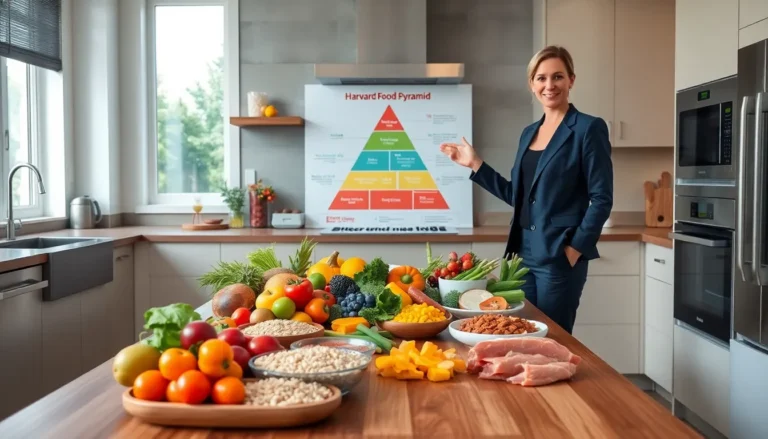Table of Contents
ToggleCreating a family budget grocery list might sound about as thrilling as watching paint dry, but it’s the secret weapon to saving money and sanity. Imagine walking into the grocery store with a plan, like a culinary superhero ready to conquer the aisles. No more impulse buys of that giant inflatable unicorn or the latest trendy snack that’ll sit in the pantry until it mysteriously disappears during spring cleaning.
Understanding Family Budget Grocery List
A family budget grocery list serves as a blueprint for effective spending. Structured planning aids in managing food expenses while promoting healthier eating choices.
Importance of a Budget
Establishing a budget ensures financial discipline. It helps families allocate specific amounts for groceries, preventing overspending. By tracking expenses, they gain insights into their shopping habits. Utilizing this information allows adjustments for future budgeting periods. Allocated funds for essentials ensure all necessary items are purchased without exceeding limits. Resources spent wisely contribute to overall financial health.
Benefits of Meal Planning
Meal planning streamlines grocery shopping. Preparing a weekly menu reduces food waste and promotes healthier choices. It allows families to use ingredients efficiently, minimizing unnecessary purchases. Planning meals in advance can save time during busy weekdays. Consider prepping bulk items for multiple meals, improving convenience. This practice enhances nutritional balance while reducing last-minute takeout orders. Families often experience reduced stress when they know what’s for dinner.
Creating a Family Budget Grocery List
Creating a family budget grocery list involves strategic planning to meet specific needs and maintain financial discipline. By focusing on thoughtful approaches, families can save on food costs while promoting healthier eating habits.
Assessing Your Family’s Needs
Assess family preferences before shopping. Identify dietary restrictions such as allergies. Consider the varying appetites of family members, adjusting quantities accordingly. Involve everyone in the process to ensure satisfaction with meals. Determine essential items, including staples like bread, eggs, and fresh produce. Evaluate past grocery purchases to pinpoint trends and avoid unnecessary items. Regularly review and update the list as needs change.
Setting a Budget Limit
Establish a specific budget for grocery expenses. Decide on a weekly or monthly amount based on family income and priorities. Aim for a realistic figure that supports planned meals. Include a contingency for unexpected purchases. Use tracking tools or apps to monitor spending effectively. Analyze previous grocery bills to identify areas for improvement. Adjust the budget as necessary to accommodate fluctuations in prices or family size. Prioritize buying seasonal and locally sourced items to enhance freshness and value.
Tips for Effective Grocery Shopping
Effective grocery shopping requires strategic planning and smart choices. Families can enhance their shopping experience by following specific guidelines.
Choosing the Right Store
Evaluate different grocery stores in the area to determine which provides the best value. Look for stores that offer competitive prices on essentials and frequent sales. Consider options with loyalty programs or deals on family-sized packages. Investigate local markets for fresh, seasonal produce at lower prices. Recognizing the store layout aids in efficient navigation, helping families stick to their budget and avoid impulse buys. Compare weekly ads for discounts on preferred brands or needed items.
Timing Your Shopping Trips
Select shopping times wisely to maximize savings and convenience. Visiting stores early in the week often provides access to fresh stock and markdowns. Mid-morning hours typically experience fewer crowds, allowing for a more focused shopping experience. Observe local patterns; some stores offer cardholder discounts on specific days. Utilize early evening or weekend afternoons cautiously, as these times might attract larger crowds. Staying informed about promotions or sales events can lead to significant savings on groceries.
Meal Ideas to Include
Including a variety of meal ideas enhances the family budget grocery list, simplifying meal preparation. Consider the following options for a balanced approach.
Breakfast Options
Oatmeal provides a hearty start to the day, offering fiber and energy. Whole grain toast paired with eggs creates a nutritious combination. Smoothies made with yogurt and seasonal fruits deliver vitamins in a delicious way. Granola bars offer convenience on busy mornings. Pancakes using whole wheat flour can be a fun weekend treat while staying budget-friendly.
Lunch and Dinner Ideas
Chili made with beans and ground turkey offers protein and can last for multiple meals. Grilled chicken paired with seasonal vegetables creates a fresh, wholesome dinner option. Pasta with marinara sauce and sautéed spinach is easy to prepare and satisfying. Stir-frying tofu with mixed veggies provides a quick, healthy dinner solution. Quesadillas filled with beans and cheese serve as a versatile lunch option that appeals to all ages.
Healthy Snacks
Carrot sticks and hummus make for a satisfying crunch between meals. Yogurt with honey and nuts delivers a creamy, protein-rich snack. Air-popped popcorn serves as a low-calorie alternative to chips. Sliced apples with peanut butter offer a sweet, satisfying treat. Trail mix containing nuts and dried fruit provides energy for active families throughout the day.
Creating a family budget grocery list is a powerful tool for managing expenses and promoting healthier eating habits. By planning meals and sticking to a budget, families can avoid impulse buys and make smarter choices at the store. This approach not only saves money but also reduces food waste and stress during meal preparation.
Emphasizing strategic planning and thoughtful shopping can lead to a more organized and enjoyable grocery experience. With the right list in hand families can feel empowered to make better nutritional choices while staying within their financial limits. Implementing these practices fosters a healthier lifestyle and contributes to overall family well-being.







